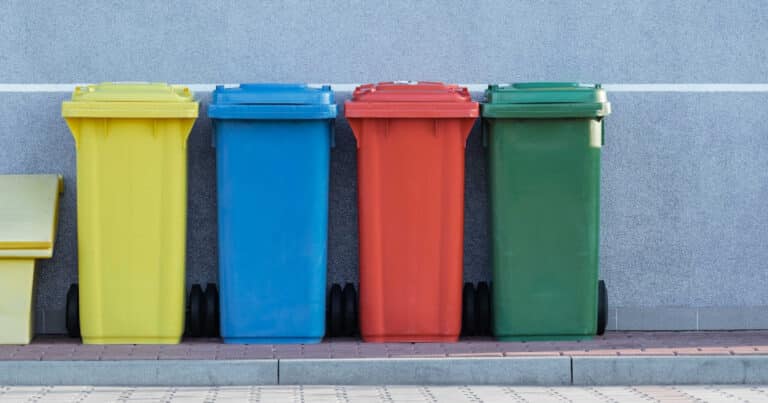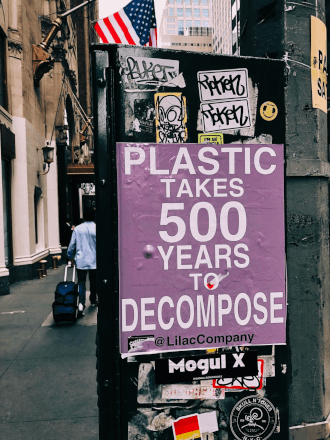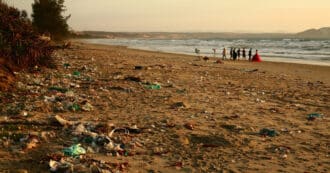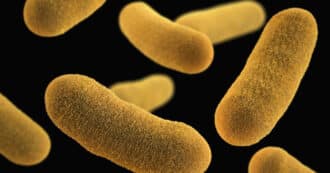By Sarah Kudishevich – On an average day, Sarah Kudishevich wakes up in the morning, makes herself some eggs that she bought package-free from her local farm, adds in some chopped veggies that she purchased in her reusable shopping bags, pours some loose leaf tea in her reusable mug, and heads out for the day.
Millions of people around the world are beginning to explore how they can make living plastic free a part of their lifestyle.
Our Plastic Footprint
We use around 100 million tons of plastic every single year. Plastic consumption globally continues to rise as we increase our reliance on single use plastic and convenience items.
The Issue With Plastic
The problem with plastic is both the way that it is manufactured and the way in which is it disposed of. Most people don’t realize that plastic is actually made from oils. There are a variety of different processes in order to produce plastic. Most of these require extracting large quantities of crude oil, natural gas, or coal from the earth. These materials then go through intense refinement and processing before they become usable.
Plastic Waste
According to National Geographic, 91% of the plastic produced never gets recycled. “The vast majority—79 percent—is accumulating in landfills or sloughing off in the natural environment as litter.”
A shocking amount of our plastic waste ends up in the oceans, impacting marine life and underwater ecosystems. Plastics that end up in landfills can leak toxic chemicals into ground waters and soils, eventually impacting the farms and agricultural systems that provide the food we consume.
Going Plastic Free
The good news is that there is something we can do about it. To start, it’s important to pay attention to our personal plastic footprint and consumption habits by noticing all the ways that we use plastic in our lives, eventually leading to less plastic usage.
Common Examples of Plastic Usage
- Plastic bags to carry our purchases home from the grocery store
- Plastic wrap to store leftovers and pack lunches
- Plastic straws at bars and restaurants
- Plastic produce bags to keep our produce fresh
- Plastic waster bottles that we purchase at gas stations, bring to work, and drink from in the home
- Plastic bottles that store items such as shampoo/conditioner, laundry detergent, soap
- Packaging for grains, snacks, meat, cheeses, and other food products
- Disposable plastic bags for storing sandwiches and packing lunches
The Plastic Test
The greatest irony comes when we start to notice the amount of time we use plastic versus the amount of time and effort it takes to produce and properly dispose of it.
The average plastic bag is used for about twelve minutes before getting tossed in the trash where it will be sent to a landfill to degrade for hundreds of years.
Simply beginning to pay attention to our use of plastic can inspire great change – both in ourselves and in those around us. Much of our plastic usage is unconscious as it is so integrated into societal habits and behaviors. The first step in a plastic free life is increasing our level of consciousness to the plastic habit that exists all around us.
The Plastic Free Journey
By deciding to begin a plastic free journey, each of us can contribute to a growing movement to reduce the amount of plastic waste we create globally.
Many of the most common plastic items that we use revolve around food packaging. Some of the plastic free alternatives that you could consider transitioning to as part of a move towards a plastic free lifestyle are listed below:
A Practical Guide To Plastic Alternatives
- Choosing to bring reusable bags to the grocery store to carry groceries from the store to your home. Store reusable shopping bags in your car to remember to take them with you when you leave to go shopping.
- Bring your own container to purchase meats and cheeses from the deli instead of purchasing these items in single use plastic packaging.
- Avoid purchasing items that come in a plastic container. If these items are unavoidable, make sure to reuse the container as many times as possible, and then properly recycle it.
- Choose a reusable water bottle instead of having to buy single use plastic water bottles.
- Purchase metal straws to bring with you when you go out to a bar or restaurant, and make sure to ask your server for no straw with your drink.
- Use reusable cloth bags for purchasing produce and keeping it fresh.
In addition to these swaps, there are several plastic free products you can consider such as bar soap and shampoo, reusable coffee cups, stainless steel containers, and many more.
The Realities Of A Plastic Free Lifestyle
It’s important to recognize that it’s nearly impossible to go 100% completely plastic free. Plastic is found in our food packaging, in our storage tools, and even in our clothing, so we won’t be able to eliminate plastic completely. However, by committing to a journey and to constantly raising our awareness of the issue in ourselves and in others, we can make a big difference.
Simply by choosing 1-2 swaps to make in your daily life, you can make a big difference in creating less plastic. While it may seem that one person changing their habits doesn’t seem like it will make a big difference, we must remember that our actions have ripple effects.
By requesting no straw at the restaurant or insisting on using your own bag at the grocery store, you are influencing all those that you are interacting with and raising their level of awareness.
This happens each and every time you make choices aligned with a plastic free lifestyle, eventually snowballing into a larger and larger movement that changes the way we think about and engage with plastic around the world.
One of the more recent phenomena in the movement towards plastic free living is Plastic Free July. Every year, millions of people take on the challenge to work towards plastic free living over the month of July. Plastic Free July is an organization that provides several resources and information on how you can go about reducing your waste.
The Three “R”s of Plastic Disposal
The last important component of a plastic free lifestyle is to become educated on proper disposal. There will inevitably be several situations in which we encounter plastic in our lives. Therefore, it is important to make sure we are properly disposing of this plastic in a conscious way.
Reduce Plastic Use
The Environmental Protection Agency teaches “Reduce, Reuse, Recycle”. First, we work to reduce plastic pollution by avoiding the purchase of unnecessary plastics.
Reuse Plastic
Next, we should do our best to reuse any plastics that we already have in our possession. Consider washing and reusing plastic containers for food storage and leftovers. You can wash and reuse plastic sandwich bags to pack lunches. You can reuse some plastics for kids art projects or some organization projects around the house.
Recycle Plastic: A LAST Resort
Only as a last resort should we turn to recycling. If we have no other option but recycling, then make sure to get educated on what plastics are being accepted at your local recycling facility and which plastics are recyclable versus not. As a general rule, hard plastics are more likely to be accepted for recycling, while softer and thinner plastics (such as plastic bags and thin packaging) must go in the trash.
Most importantly, commit to a plastic free lifestyle by making a lifelong commitment to plastic awareness. As Sarah Kudishevich writes in her book, The Zero-Waste Workbook, “Our success should be measured by whether or not we are engaging with the journey and raising our awareness about waste and the awareness of those around us, not by how small of a container we can squeeze our waste into.”
Religion & The Plastic Free Life
An article on MDPI called, “The Reincarnation of Waste,” gives a fascinating case study of how the Buddhist teacher, Dzongsar Jamyang Khyentse Rinpoche, used spiritual ecology to initiate a waste reduction project in Bhutan. Rinpoche was successful by “engaging cultural and spiritual values, and drawing on the inspirational qualities of social and spiritual leaders.” He helped created “the Samdrup Jongkhar Initiative’s Zero Waste project” which addresses household waste management and waste reduction.
The article discusses how before the 2000s, there were few manufactured consumer products in the rural areas of Bhutan. Just as karma and rebirth were central ideas in their Buddhist religion, items were used and reused in creative ways; items were frequently “reborn” for new purposes and rarely tossed. But as cheap manufactured items became more readily available, this ethic of reuse began to wane, and disposal items began filling the streets as garbage. In the words of the historian Karma Phuntsho, “People initially fell for the new, light, cheap and weather-proof materials [plastic and other synthetic materials] but their attraction is slowly fading away as the non-biodegradable synthetic materials outlast their use, clogging drains or littering even remote sacred sites.”
The Zero Plastic Waste Project
Buddhist teacher, Rinpoche, helped start the Samdrup Jongkhar Initiative (SJI) which is addressing plastic pollution in a variety of inspiring ways. SJI organized “Zero Waste Festivals,” in which, “school children performed Zero Waste dances, wearing costumes fashioned from waste materials like plastic wrappers, bottles, and straws Lindström 2012, p. 7). The festivals included presentations on composting and bio-gas techniques from Indian experts, as well as a recycled art workshop by an expert from the USA (Lindström 2012, pp. 8–9)”. SJI’s Zero Waste project also “provides education and support to help local producers create goods by re-using discarded materials.” The Zero Waste Project helped train people to turn “strips of plastic bottles and wrappers… into bracelets, belts, and bags,” and to make “bags, boxes, brooches and other jewellery [sic] from used truck inner tubes, plastic bottles, wrappers and used phone vouchers” (Lindström 2012, p. 13).
Make Change in Your Community
Rinpoche shows us how achieving the plastic free life can be a national and religious enterprise. What would it look like for each of us to do the same in our communities?
Who knows, perhaps we were born into the religion and country we live in for just this very purpose.
* Featured image source










Why not promote converting plastic bottles into solar bulbs? It is not at all an expensive thing.